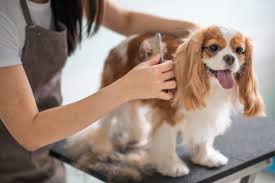The booming flowers during this springtime period along with extended daylight create new opportunities for both pets and their owners. The season delivers health risks to your pet that necessitate focused pet care for their well being. The spring pet care advice provided in this article ensures safety alongside health and happiness for pigs as well as cats.
Watch Out for Fleas and Ticks
Flea and tick season starts its yearly cycle during the spring time. Cold weather transitions into spring conditions because they create an environment that allows fleas and ticks to multiply quickly. Tiny parasites known as fleas and ticks bring about itching symptoms and allergic reactions and transmit harmful medical conditions such as Lyme disease as well as tapeworm infection.
What You Can Do:
- Flea and tick preventives derived from veterinary references should be your preventive option.
- Regularly examine your pet’s fur starting from the ears before moving to the belly and ending at the paws when they finish playing outdoors.
- Trim your lawn to a short height since this reduces areas where ticks can hide.
Grooming for Shedding Season
Pet owners need to focus on grooming their animals during shedding season since it becomes a critical time for pups to shed their winter coats. Brushing your pet regularly enables both a better appearance and reduces household hair production and helps prevent discomfort and inflammation affecting their skin.
Spring Grooming Tips:
-
- To maintain your pet’s fur condition, routine brushing should occur two to three times each week, but daily brushing suits breeds with lengthy fur.
- Contact a professional groomer to eliminate excessive fur and perform thorough cleaning under difficult-to-access areas of the body.
- A vet-approved wash with gentle shampoo allows you to bathe your pet for coat renewal.
Protect Against Allergies
Pet animals experience seasonal allergies in the same way human beings do. Spring allergies including mold contamination along with pollen and grass trigger various reactions from sneezing to itchy skin and watery eyes or skin irritation in dogs and cats.
What to Look For:
- Excessive licking or scratching
- Red or inflamed skin
- Sneezing or coughing
Symptoms need professional evaluation from your vet. The vet will prescribe suitable allergy drugs and nutritional changes to manage the symptoms.
Stay Safe During Outdoor Adventures
You should consider enjoying spring activities through either hiking or backyard games or walking with your pet. You need to implement measures that protect your pet while they are enjoying outdoor activities.
Safety Tips:
Your pet should use a secure leash combined with notable collar tags that contain current identification information.
Besides ensuring microchipping your pet makes sure it gets proper registration.
Stay away from treatment zones where pesticides or fertilizers are in use.
Drivers should always carry fresh water that protects their pets from overheating and dehydration.
To protect cats from traffic accidents predators and being lost outdoor time should either remain under supervision or they should be kept in secure enclosures.
Beware of Toxic Plants and Garden Chemicals
Pay attention to the dangers that toxic plants together with garden chemicals present Tulips together with daffodils and lilies along with numerous other spring flowers constitute toxic substances for pets demanding pet care through avoidance or prompt veterinary action. Fertilizers all together with herbicides and insecticides have been found to cause severe health issues.
Prevention:
-
- Maintain your pets inside the area where they should not roam around garden plants or new growing zones.
- Store every chemical used for lawn care and gardening purposes in locations that are inaccessible to everyone.
- Use alternatives for gardening features which are safe for pets.
Active Exercise and Following a Diet Plan Should Be Maintained Regularly
An important point of pet care is to increased physical opportunities emerge when spring brings extra vitality. The routine practice of exercise lets pets stay at a healthy weight and diminish stress and create positive behavioral outcomes.
Ideas:
- Enrichment games like treat puzzles
- Safe playdates with other pets
- You should provide your pet with daily walks along with fetch and interactive toys.
Before making dietary changes to your pet’s meals consult your veterinary professional for guidance since activity levels can determine an appropriate portion change for spring pet care.
Final Thoughts
The natural beauty of spring provides an excellent opportunity to develop fresh memories while spending time with your pets outdoors. Simple essential pet care instructions during spring will help your pets experience the season to the same extent that you do.
Staying current with knowledge applies together with essential planning leads to the most significant outcome which is pure enjoyment. Have any questions about this beautiful bread? Drop a comment below or contact us at Pet Pals USA. We’re here to help!



2 Comments
Pingback: The Ultimate Guide to Dog-Friendly Houseplants: Keep Your Pup Safe and Your Home Green - testing
Pingback: Seasonal Pet Care Tips: Keeping Your Pets Happy Year-Round - testing